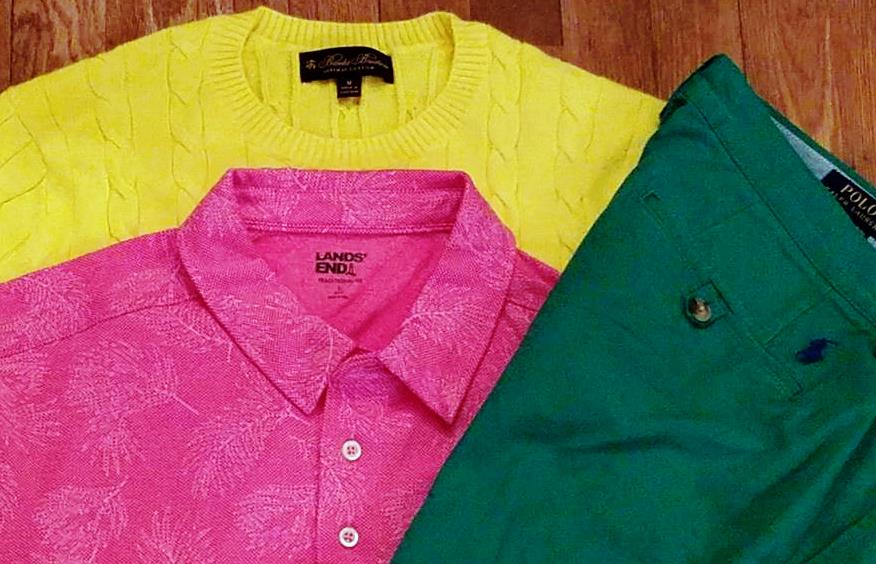In my previous post I described “Preppy” as essentially an international phenomenon, particularly for men. I made the point that in America the term “Preppy” has a pejorative connotation, conjuring up images of young, entitled snobs. (While for feamales, however, it is often synonymous with “cute.”) For that reason those America males who do appreciate the Preppy aesthetic prefer to refer to themselves as “Trad,” while retailers that continue to sell “Preppy” prefer to call it sportswear. However, there are a handful of (male) American enthusiasts who continue to wear Preppy as a badge of honor and make no apologies about it: they wear it loud and they wear it proud.
There’s something deliciously subversive about Preppy in America, particularly for males. It is as if you aren’t supposed to have it. Shopping for Preppy is almost like a man shopping for his wife or girlfriend at Victoria Secrets. Can you imagine a man asking a female sales associate for a polo shirt that is in hot pink? Furthermore, you may have to scour the internet or eBay and even the world to find it. And, if you should find it, it is usually decidedly expensive.
Before we go any further in our journey into Preppy Land, I think it is necessary to first address the 900 pound gorilla in the room: The Official Preppy Handbook. First published in 1980, it was a tongue-in-cheek treatise on the privileged lifestyle of the wealthy North-Eastern elites that the book refers to as “Preppies.” This now out-of-print book soon became the “bible” on Preppy fashion and lifestyle.
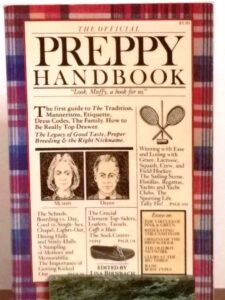
The Official Preppy Handbook
The problem here is that this book, which is over-forty years old– I don’t believe was ever revised– is still considered to be the last word by many as to what is and isn’t “Preppy.” You contradict it at your own peril. (From here on in I will refer to it as The Handbook.) Case in point is the Lilly Pulitzer clothing line.
Lilly Pulitzer: She was a wealthy socialite who lived in Palm Beach, Florida. In the late 1950’s, to keep herself amused, Ms. Pulitzer opened a juice stand. However, one of the hazards of this endeavor was that the different colored juices would splash onto her clothes; in a sense ruining them. Ms. Pulitzer came up with a brilliant idea to solve this problem: she had a dress maker create a dress for her that closely matched (or camouflaged) the unsightly juice stains that she suffered on a daily basis. Surprisingly, her dresses became an instant hit with her socialite friends, prompting her to sell copies of them at her juice stand. Thus launched the very successful Lilly Pulitzer line of dresses for women—and clothing for men (which was later discontinued).
Although the Lilly Pulitzer brand has prospered over the years, it has found few friends among fashion critics: “she’s wasn’t really a designer” or “clothing not fashion” have been some of the disparaging mantras. But because it was included in The Handbook, say what you will about these dresses, you cannot deny that they are Preppy. If The Handbook says something is Preppy, you better believe that it is.
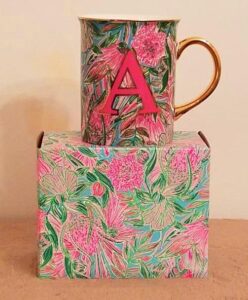
Another example of the power of The Handbook relates to the “Bean” boot. L.L. Bean was a manufacturer and retailer little known outside of its home state of Maine. Well, Maine is a place where many of the Old Money elites depicted in The Handbook spent their summers or sent their children to summer camp. So it is not surprising that the well-made products of this unassuming enterprise would come to their attention.
The Bean Boot: L.L Bean was and still is a manufacturer and outfitter of hunting and general outdoor clothes. One such product that caught the attention of The Handbook was a boot made for duck hunters, which would soon come to be called “The Bean Boot “or duck boot. If you have ever seen a Bean Boot (not pictured here), you might wonder what all the fuss is about. Practical it may be (for duck hunters), but elegant it is certainly not. However, because The Handbook considered it a Preppy essential, you had better consider it essential, too. For the remainder of this post, if my selections are in accordance with The Handbook, I will endeavor to indicate so. And if they differ, I will indicate that, too.
Preppy vs. Ivy:
In my previous post I covered this subject, but in brief I will restate it again. Ivy was what the children of the Old Money elites wore (e.g. jackets and ties) when they went to class at the elite Ivy League colleges (e.g. Harvard and Yale); Preppy is what they wore when they were not in class or away from school (either Prep School or college). It is worth noting that what they wore when not attending class was sports inspired. But related to sports which few people played in America, such as polo, cricket and rugby.
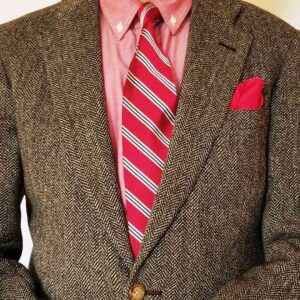
The Color Palette
Preppy is all about color: And the bolder and brighter the colors the better. The three core Preppy colors are bright green, bright yellow and bright (“hot”) pink. The Handbook was not enamored with at least two of these preferences, stating:
The wearing of the pink and the green is the surest and quickest way to Group identification within the Prep set. …Not any shade of pink and green will do. No, this is unabashed , outrageous go-for-broke hot-hot pink and hubba-hubba electric wild lime green.
If that wasn’t enough of a lambasting, The Handbook went on to include a coloring book page where readers were encouraged to color the picture pink and green. Fortuitously for lovers of Preppy, the over one million purchasers of the book–and the clothing retailers that cashed in on it—strenuously disagreed with such a negative assessment.
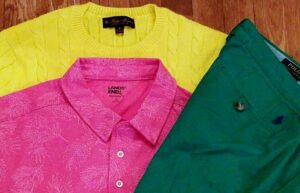
Not all of the Preppy color palette is hot, hot, hot or hubba, hubba. There are the colors that take Preppy back to its New England nautical roots: red, white and blue (see below).
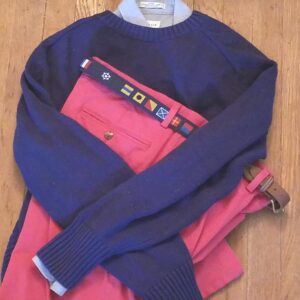
Layering
Nothing is more indicative of Preppy than layering. Here is an explanation of the practice as described in The Handbook:
Layering means a tweed jacket over a Norwegian sweater over an oxford cloth shirt over a Lacoste [polo shirt]. And a down parka over everything. And rubber foul-weather–gear over that.
For the true Preppy there is nothing that cannot be improved upon by layering.
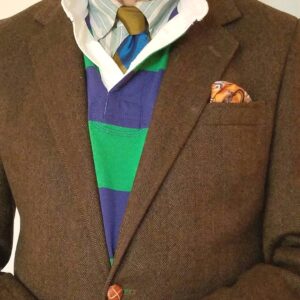
Sweaters
In case you haven’t already noticed, Preppy is sweater-centric. And the sweater of choice is the crewneck—whether wool or cotton. The V-neck sweater is Ivy; the only time a Preppy would wear one would be if it were a cricket/tennis sweater (to be shown further on).
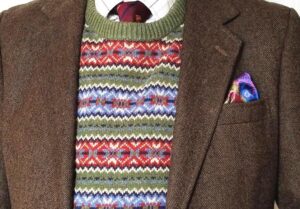
Outerwear
There are only three Preppy categories of outerwear, and they are as follows in order of least warm: the Barn or Chore coat, the Puffy/quilted Vest, and the Barbour Wax Jacket. The Barn Coat is rather practical for Spring and Fall; furthermore, they are quite reasonably priced—usually well under $200. The Handbook doesn’t use the terms Barn or Chore coat, but instead refers to L.L. Bean’s version, called a “Field” jacket and which L.L. Bean still sells today. The Puffy or Down Vest,I am sure, is self-explanatory.
The Barbour Wax Jacket will surely keep you warm in the cold winter months, but it is quite pricey. You might ask why, in this age of no-iron shirts, you would want to buy a jacket that needs to have wax reapplied at least once a year (a messy process), but I don’t make the rules about what is Preppy and what is not. (For some reason The Hanbook makes no mention of the Barbour jacket; perhaps it was not widely available in the United States at the time of the book’s initial publication.)
I apologize for having no examples of Preppy outerwear to show you, but in this age of global warming, my non-Preppy outerwear suits me just fine.
Suits
Preppy is definitely not about suits. Not at all. However, a seersucker suit with a bow tie would certainly be appreciated at a summer garden party where many of the ladies are wearing Lily Pulitzer dresses.
Sports Jackets
Here the RL-67 is the jacket of choice. It is not one jacket, but a family of jackets in wool, tweed, wool and silk, and linen. The color is always a mid to light brown; and the most sought after patterns are houndstooth and glen plaid. However, like most things Ralph Lauren, these jackets are rather pricey, costing over $1,000; even on eBay these jackets go for at least $500.
As an alternative to the RL-67, you might consider a regular tweed jacket. You can find many fine examples for under $100 on eBay; but make sure they are brown. Why brown and not gray? Because gray is not a Ralph Lauren color, and he sets the standard for the Preppy color palette.
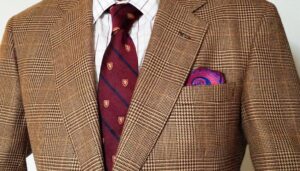
Other Preppy sports jackets include seersucker and madras. The Navy Blazer, while not really a Preppy essential (my opinion, not that of The Handbook) does have its uses, though. See below.
Headwear
There is not much in the way of headwear in Preppy World, but then there is not much in the way of headwear for men in any world.
I would just go with a baseball caps in a Preppy color. Of course those with the Ralph Lauren logo are the most popular. My personal favorite is a cap with his teddy bear logo (regrettably, I don’t currently own one). Then there is the straw Boater if you really want to get fancy. For the winter months a wool flat cap will do just fine.
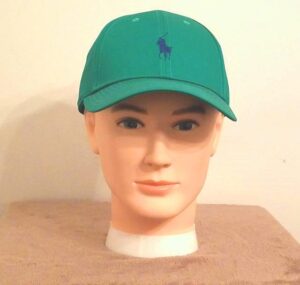
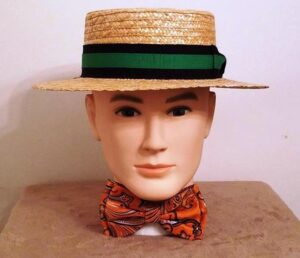
Shirts
Rugby Shirts: The more the better. Ralph Lauren has the brightest colors. Preferably they should be worn layered.

Polo Shirts: You want them in all the Preppy colors. The Handbook says that Lacoste polos are preferable, but Ralph Lauren’s polos are the most ubiquitous among both Preppies and non-Preppies.
Gingham, Tattersall, Graph Check Dress Shirts: You will definitely want one of these when wearing a tie and jacket. With the Ginghams you definitely want them in Preppy Colors. In no instance should they be button-down—that’s Ivy (See Below). Good luck in finding such shirts that are not button-down. Most likely you will have to get them from the UK. Cording’s of Piccadilly is a good source for traditional Tattersall Shirts, although Brooks Brothers does have a few.
Oxford Broad-Cloth—or any other kind of Button-Down Shirts: They are not Preppy; they are Ivy. However you might get away with wearing one if you wear it under a crewneck sweater.
(Vertical) Stripped Shirts (e.g. Bengal, candy stripe, pin stripe, etc.) are not Preppy. They are Classic.
Pants
Chinos: They should be in Preppy colors. As for khaki colored chinos, they are Ivy. I know that The Handbook disagrees with me on this, but I believe that this is actually a matter of semantics. The Handbook doesn’t make a distinction between Preppy and Ivy: I do. However, there is one instance when khaki chinos are acceptable for Preppy: when worn with a navy blazer and a cricket/tennis sweater.
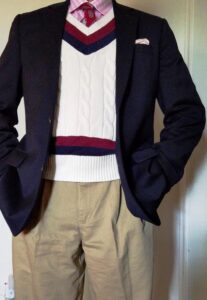
For those of you that are adamant that khaki is indeed a Preppy color, I am certainly not the last word on that subject: go ahead and make them part of your Preppy outfits.
Nantucket Reds: Ordinarily, red is not a Preppy color. However, a particular shade of it did become Preppy on Nantucket Island in the 1950’s. It was introduced by Philip C. Murray of Nantucket’s Murray’s Toggery Shop; supposedly it was inspired by pants worn by Breton fisherman. The color is a sort of a “faded” shade of red. The pants became popularized by the late President John F. Kennedy when he wore them while playing golf in the early 1960’s.
It appears that Murray’s Toggery Shop may be the only entity that can use the name Nantucket Red, owing to trade mark issues. So it is that other retailers have their own interpretation of the color; Brooks Brothers’ is called “brick.” My own pants are called “coral cave.” But if you want to be a purist, get the real thing from Murray’s Toggery.
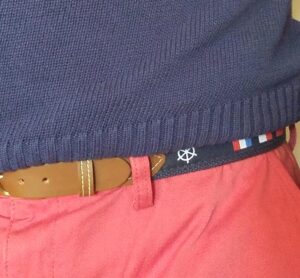
Jeans: Definitely a No-No, and I think The Handbook would concur with me on that; however it makes an exception for women, but only if they are very beat-up, straight-legged and Levi’s. Keep in mind that in International Preppy jeans may be acceptable. If you really want to wear a pair of jeans with a rugby shirt that you have layered with a tweed jacket, there are no Preppy Fashion Police to prevent you from doing so.
Corduroy: For the Fall and Winter, these are the only acceptable Preppy pants; and The Handbook concurs with me on that point. And not any type of corduroy will do: It needs to be wide-wale and in Preppy colors. “Wale” refers to the number of ridges in the fabric per inch. For Preppy, that should be 8-wale or less. With corduroy we may expand the Preppy palette somewhat with Fall colors such as burgundy and burnt orange. Wide-Wale corduroy pants are hard to come by in the U.S.; particularly in a wide variety of colors. Peter Christian in the U.K. is a good source for wide-wale corduroys in a variety of the aforementioned colors. (Brooks Brothers sells them but with a limited selection of colors; J. Press sells wide-wales, too.)
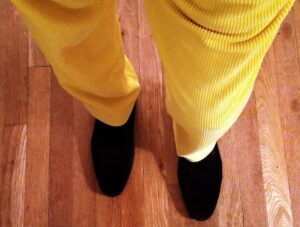
White Ducks: This is what The Handbook calls white linen pants. A great choice for summer garden parties.
Four-Panel: The Handbook describes them thus: “Each of the four large pieces of fabric from which the pants are constructed is a different (Prep) color.” The only retailer I could find to have actually marketed such pants in this century was Vineyard Vines; and that was in 2015 or earlier. However, this year Brooks Brothers has something similar in seersucker that they call Fun Pants.
Lilly: The Handbook states that they are: “Practically an admission requirement at many country and yacht clubs.” Sadly, Lilly Pulitzer discontinued its men’s line some time ago. You can purchase the pants on eBay, but only if you are willing to pay a small fortune. There are alternatives, however, e.g. Brooks Brothers. (See Go-To-Hell, below.)
Go-To-Hell: In 1975, in a article written for Esquire Magazine, the late Tom Wolfe, an acclaimed writer and social critic, noted the bizarre way (to him) Boston elites dressed when vacationing on Cape Cod’s exclusive Martha’s Vineyard:
The jackets were mostly navy blazers. . .but the pants had a go-to-hell air : checks and plaids of the loudest possible sort, madras plaids, yellow-on-orange windowpane checks, crazy-quilt plaids, giant houndstooth checks, or else they were solid airmail red or taxi yellow or some other improbable go-to-hell color.
The significance of these “garish” outfits, along with the conservative jackets and ties, was not lost on Mr. Wolfe. The message being sent out by the wearers of such attire was unmistakable:
We are the Elites. We can dress like this and not be laughed at But you can’t. (This is my own phrasing, not necessarily Mr.Wolfe’s.)
Over the years go-to-hell pants have become considerably toned down. In place of loud checks, we have unimaginative pants with embroidered animals (critter pants). And as for the “improbable go-to-hell” colors, they have become standard Preppy. I must say that this sanitizing of go-to-hell pants has left me displeased. I find critter pants more go-to-pre-school than go-to-hell. I say, let’s have The Full—In Your Face—Monty!
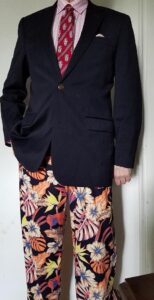
Shorts
The same as pants, but you can add madras.
The Neck Tie
There are only two categories of ties–besides bow ties–that are genuinely Preppy. They are the Crest (or Club) and knit ties. For the former, it should not be for an actual school or club. It is imperative that it be a club tie for a non-existent club—never a real one. And that goes for club ties for schools or organizations you actually went or belong to. Save them for alumni reunions or club functions!
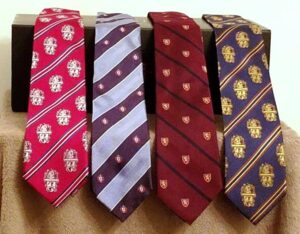
I know that there are those who would look disapprovingly at someone wearing a club tie for a non-existent club just as they would at someone wearing an actual club tie for a school or club for which they never attended or belonged to. And to them I would say : Get over it! Preppy is all about fun, not social status. It doesn’t take itself seriously, and neither should you.
As for the knit tie, it is an excellent choice for those occasions where you might not want to wear a club tie—e.g. where there may be people wearing real club ties—or just for adding some variety to your Preppy outfits.
Belts
A needle-point belt would be ideal, but pricey. As an alternative you might go with a considerably less expensive embroidered belt with a nautical theme.
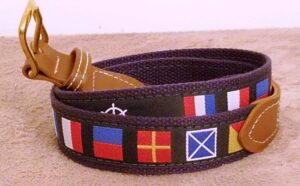
Footwear
The Penny Loafer is a Preppy essential (as it is for Ivy). Make sure that it has the raised stitching over the arch and toes; this you will find in most American brands, but rarely in loafers not made in the U.S. It can be worn with or without socks.
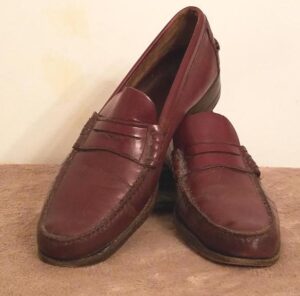
Next in importance is the Sperry Top-sider, which is a shoe that was originally meant to be worn on boats, but in Preppy World seldom is. They should only be worn without socks. And then there is the Bean Boot, which we have already discussed.
Watches
Preppy is not about bling, so leave the Rolexes and Patek Phillipe’s locked-up at home. An inexpensive watch with a nylon striped band (Nato strap) will do just fine. And a vintage wind-up Timex would be an excellent watch choice.
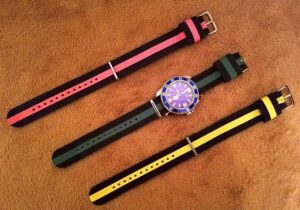
Where to Buy It
Building an authentic Preppy wardrobe is not easy, nor is it cheap. In fact it might take years for you to do so, often requiring you to resort to eBay and other such platforms for the rarer and costlier items. Here are the best sources for Preppy in the U.S (keep in mind that most of the following are on the expensive side—but then there are sales):
Ralph Lauren: The home of everything Preppy. RL doesn’t use the word Preppy in his ad campaigns, but you know that is what he is selling. (Of course, Ralph Lauren embraces all aspects of fashion and many styles, not just Preppy.)
Brooks Brothers: This brand has long been associated with Ivy. However, the brand is now under new ownership, and I have noticed that it is carrying a lot more Preppy-oriented items: particularly sweaters and pants
J .Press: This retailer sells classic Ivy 52 weeks out the year. And when I say classic Ivy, I mean 1950’s Ivy. Nevertheless, it does sell certain Preppy items that you will have a hard time finding elsewhere, such as ties.
Of the above three retailers, only the latter two are noted in The Handbook. Mention of Ralph Lauren is conspicuously absent. Bear in mind that at the time of the book’s publication, Ralph Lauren was already a fashion powerhouse and was decidedly Preppy. The reason for this glaring omission I would speculate is due to the fact the Old Money elites that originated Preppy never forgave him for what they considered to be the appropriating of their style of dress and life style.
J. Crew: Compared to the above three, it is a “new kid on the block.” In the 1990’s and early “2000’s, it was synonymous with Preppy. Still a good source for sweaters. Not cheap, but excellent quality.
Banana Republic and Land’s End: From time to time they may carry Preppy items.
Vineyard Vines: Definitely Preppy
Kiel James Patrick: Refers to itself as “Classic New England Fashion.” Sounds like Preppy to me.
Uniqlo: Many of my Preppy followers on Instagram have found Preppy items there at reasonable prices.
Final Thoughts
I find it amazing that that at least 80% of what is described as Preppy in The Handbook (over 40 years old) is still relevant today, at least for males. For what other current fashion can you say the same thing?
I am sure that some of you may feel that I have been remiss for hardly mentioning the distaff side in relation to Preppy. There is a simple explanation for this: it is way above my pay grade.
Preppy: Wear it loud and Wear it proud!
